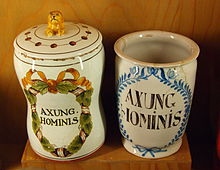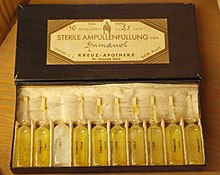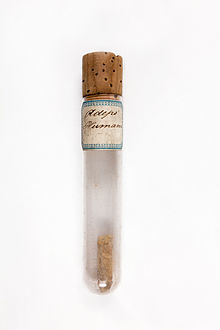Human fat was mentioned in European pharmacopoeias since the 16th century as an important fatty component of quality deemed ointments and other pharmaceuticals in Europe. In old recipes human adipose tissue was mentioned as Pinguedo hominis, or Axungia hominis.[2] The German medicinal Johann Agricola (1496–1570) described the recovery of human fat and its applications.



In traditional medicine in Europe, human fat was believed to have a healing magic significance until the 19th century. Many executioners recovered the fat from the bodies of their executants, called "Armsünderfett" or "Armsünderschmalz" (German: fat or grease from poor sinners put to death), and sold it.[3] For some executioners the marketing of human fat was a major source of revenue.[4] The human fat was used to make ointments for treatment of various diseases such as bone pain, toothache and gout. It was also regarded as a panacea for particular diseases associated with cachexia (e.g. tuberculosis).[5] Also an analgesic effect in rheumatoid arthritis was given to human fat.[6]
From the late 19th century, human fat was produced and offered under the trade name Humanol as a sterile, liquified preparation for injections in Germany. In 1909 it was introduced for surgical treatment of scars, wound disinfection, and wound revisions. In the 1920s it became out of fashion after low cure rates and the incidence of fat embolisms caused by its application.[7]
Until the 1960s various manufacturers offered alleged wrinkle creams for external use (Hormocenta of Hormocenta Cosmetic Böttger GmbH, or Placentubex C of Merz Pharmaceuticals) containing human fat from placentas collected from midwives and obstetric departments for industrial purposes. The use of human placentas was terminated in favour of animal products. In 2009,[8] a group of Peruvian gangsters, nicknamed "pishtacos" by the police, was accused of having manufactured and marketed human fat. However, the Peruvian Ministry of the Interior later described these allegations as a hoax.[9]
Myths
editBoth Spanish (sacamantecas) and Peruvian (pishtaco) folklore contain examples of monsters or criminals who murder human victims for their fat. Manuel Blanco Romasanta[10] (1809–1863), the first serial killer documented in Spain, was accused of extracting fat from his victims to sell in Portugal, exchanging an ounce of fat for an ounce of gold.
This folk belief survives to the modern day. In Latin American urban legends, it is claimed that human fat is used to grease bells for better sound, or applied to modern machinery such as railways or airplanes.
See also
edit- Soap made from human corpses – Alleged Nazi atrocity
References
edit- ^ Collection of hamburgmuseum, Hamburg, Germany
- ^ Ferdinand Giese: Chemie der Pflanzen- und Thierkörper in pharmazeutischer Rücksicht. Hartmann, Leipzig 1811, p. 337 (German)
- ^ Christiane Wagner, Jutta Failing: Vielmals auf den Kopf gehacket … In: Galgen und Scharfrichter in Hessen. Naumann, Nidderau 2008, ISBN 978-3-940168-17-7 (German)
- ^ Menschenfett war früher ein begehrter Rohstoff. In: Die Welt dated 20. November 2009, ISSN 0173-8437
- ^ Adolf Wuttke, Detlef Weigt (Edts.): Der deutsche Volksaberglaube der Gegenwart. Superbia, Hamburg 1860 (German)
- ^ Philip Bethge: Die Heilkraft des Todes. In: Der Spiegel. Vol. 63 (2009), No. 5 of 26. January 2009 (German)
- ^ H. Koch: Fettembolie durch Humanolinfektion. In: Deutsche Zeitschrift für Chirurgie. Vol. 186 (1924), pp. 273–278 (German)
- ^ "Police in Peru say gang members killed people to drain their fat for cosmetics". Los Angeles Times. 20 November 2009. Retrieved 4 August 2024.
- ^ ""Körperfett-Morde" stürzen Polizeichef" (in German). 2 December 2009. Retrieved 3 December 2009.
- ^ “O HOME DO UNTO” Archived 2011-11-09 at the Wayback Machine, Romasanta, memoria cierta de una leyenda, Xosé Domínguez. Quotes
- Vicente Martínez-Risco Agüero, Discurso de ingreso en la Real Academia Gallega, Editorial Moret, La Coruña, 1971
- Document by the mayor of Nombela, partido judicial of Escalona, province of Toledo. Part of the cause against Romasanta.